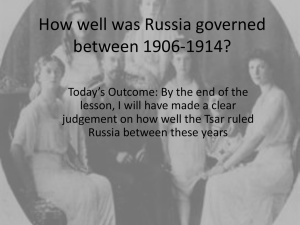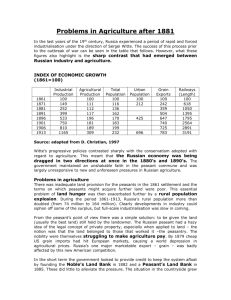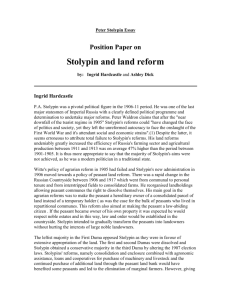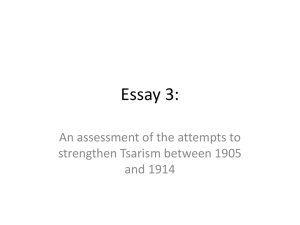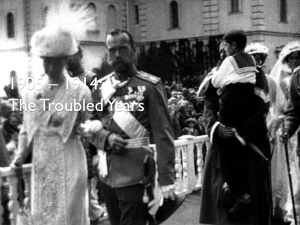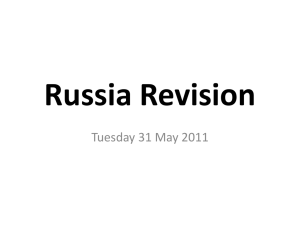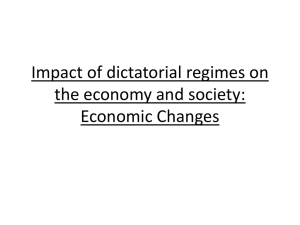russia 1905-1914 - holycrosshistory
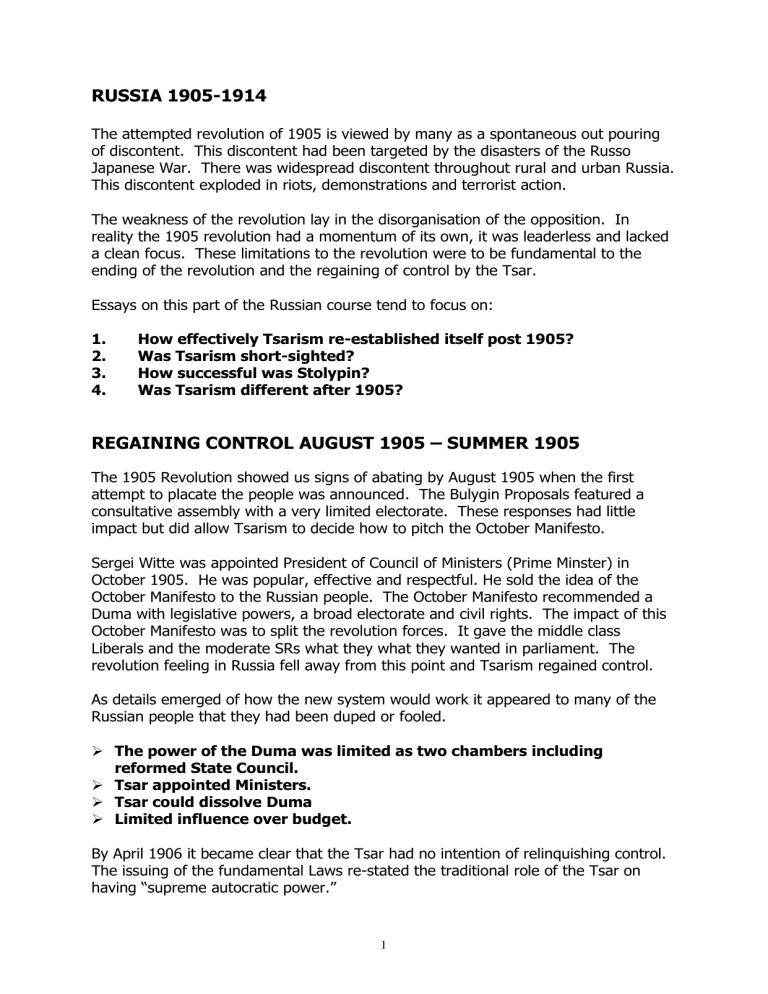
RUSSIA 1905-1914
The attempted revolution of 1905 is viewed by many as a spontaneous out pouring of discontent. This discontent had been targeted by the disasters of the Russo
Japanese War. There was widespread discontent throughout rural and urban Russia.
This discontent exploded in riots, demonstrations and terrorist action.
The weakness of the revolution lay in the disorganisation of the opposition. In reality the 1905 revolution had a momentum of its own, it was leaderless and lacked a clean focus. These limitations to the revolution were to be fundamental to the ending of the revolution and the regaining of control by the Tsar.
Essays on this part of the Russian course tend to focus on:
1.
How effectively Tsarism re-established itself post 1905?
2.
Was Tsarism short-sighted?
3.
How successful was Stolypin?
4.
Was Tsarism different after 1905?
REGAINING CONTROL AUGUST 1905 – SUMMER 1905
The 1905 Revolution showed us signs of abating by August 1905 when the first attempt to placate the people was announced. The Bulygin Proposals featured a consultative assembly with a very limited electorate. These responses had little impact but did allow Tsarism to decide how to pitch the October Manifesto.
Sergei Witte was appointed President of Council of Ministers (Prime Minster) in
October 1905. He was popular, effective and respectful. He sold the idea of the
October Manifesto to the Russian people. The October Manifesto recommended a
Duma with legislative powers, a broad electorate and civil rights. The impact of this
October Manifesto was to split the revolution forces. It gave the middle class
Liberals and the moderate SRs what they what they wanted in parliament. The revolution feeling in Russia fell away from this point and Tsarism regained control.
As details emerged of how the new system would work it appeared to many of the
Russian people that they had been duped or fooled.
The power of the Duma was limited as two chambers including reformed State Council.
Tsar appointed Ministers.
Tsar could dissolve Duma
Limited influence over budget.
By April 1906 it became clear that the Tsar had no intention of relinquishing control.
The issuing of the fundamental Laws re-stated the traditional role of the Tsar on having “supreme autocratic power.”
1
Control had been regained with no real loss of power. Sergei Witte was dismissed in
April 1906 to be replaced with Stolypin, a notorious hardman. Witte had served his purpose by convincing the Russian people of the genuine nature of the October
Manifesto. The Tsar had regained control over Russia but in the process had lost the trust of many Russians.
THE WORK OF STOLYPIN IN PUTTING DOWN OPPOSITION
Stolypin came to power as the Interior Minister in May 1906, then as Chief Minister in
July 1906 (Prime Minister). He came to power with a formidable repretation for sever repression which had been used whilst he was the governor of Saratov province. This province had been an especially troublesome area which Stolypin had pacified with repression.
He came to power in Russia in a situation that was no longer revolutionary but was still dangerous. Stolypin realised the value of repressive action but was different from his predecessors in that he also realised the limitations of violent repression.
Tactically there were for different options open to Stolypin. There are only so many ways in which a government can oppress its people. Tsarism’s Russia was already familiar with most of these methods. Stolypin used a combination of methods which included:-
exile to Siberia
floggings
martial law and military courts
execution, over 3,000 executed 1906-1909 (noose became know as “Stolypin’s necktie”)
secret police
censorship
*See (3a)
No one would argue Stolypin was original in terms of methods used, but some historians suggest there were key differences to:-
*STOLYPIN & RUSSIFICATION
Stolypin was a fervent Russian nationalist who wanted to promote the Russian way of life and language. He continued with the repression of other minorities. Stolypin also gave official encouragement to organisations which victimised and persecuted minorities. This was especially true of a group called the Black Hundreds who were as extreme Russian nationalist group (almost a gang of bullyboys). This group carried out officially sanctioned attacks or programs on Jewish communities forcing many to flee. This identification of Jews as scapegoats was popular with many
Russians.
2
Source A
In the spring of 1911 the dead body of a thirteen-year-old boy was found in
Kiev and widely spread rumours of a Jewish ritual murder led to the arrest of a Jew names Mendel Beilis. There was prolonged uproar in the press and a final great surge of public feeling before the accused man was brought to trial in Kiev towards the end of September 1913. Hundreds of foreign correspondents were present. As the trial proceeded a damaging weight of evidence was accumulated of official instigation of rumour and the corruption of witnesses. Behind all the plotting and perjury, a policy of diverting criticism from the government to the Jews was revealed. The person responsible was no other than the Minister of Justice for the previous seven years, IG
Shcheglovitov. Feelings of acute embarrassment had been aroused in conservative quarters by the time the charge of ritual murder was dropped a month later and the accused man acquitted.
Richard Charques, The Twilight of Imperial Russia (1958)
1.
What does Source A reveal about the motivation for mistreatment of the Jews repression under Stolypin?
DIFFERENCES?
1.
Stolypin was extremely effective at brutality unlike some of his more incompetent predecessors. He came to power with an established reputation which he built upon by appearing business like and detached, almost unemotional, about repression.
2.
Stolypin realised the value of speed and publicity. Punishments were quick and public to make maximum impact.
3.
“First pacification, and then only then, reform.” Stolypin had a dual approach.
Short term he wanted to regainfull control but in the long term he wanted to improve life in Russia. This gave Russians, especially the middle classes, a glimmer of hope which steered some from revolution. His dual approach revolved round the “Carrot and Stick”.
3
SUCCESS OF REPRESSION UNDER STOLYPIN
SOURCE A
YEAR
1905
1906
1907
1908
1909
1910
1911
1912
STRIKES
13,995
6114
3573
892
340
222
466
2032
STRIKERS
2,863,173
1,108,406
740,074
176,101
64,166
46,623
105,110
725,491
POLITICAL
STRIKES
6024
2950
2558
464
50
8
24
1300
POLITICAL
STRIKERS
1,082,576
514,854
521,573
92,694
8863
3777
8380
549,812
1913
1914
2404
3534
887,096
1,337458
1034
2401
502,442
985,655
Figures compiled by the Russian Ministry of Trade and Industry for strikes in factories covered by factory inspection. Quoted in Martin McCauley.
Octobrists to Bolsheviks: Imperial Russia 1905-1917 (1984)
1.
Describe the statistics in Source A.
SOURCE B
PEASANT DISORDERS
1905 3228
1913 128
A much briefer set of statistics compiled from police reports as quoted in
J N Westwood Russian History 1812-1971
2.
What are the problems with these sets of statistics?
3.
Do both sets of statistics suggest that Stolypin’s repressive tactics are working?
4
SOURCE C
Numbers killed or wounded by terrorist attacks 1905-09
1905
1906
1907
233
768
1231
358
820
1312
591
1588
2543
1908
1909
394
202
(Figures available up to 1 6 1909 only)
615
227
1009
429
Figures originally included in telegrams from Sazonov, Minister of Foreign
Affairs, to Benkendorff, Ambassador to London; quoted in
Martin McCauley, as above.
4.
How do the statistics in Source C disagree with A and B?
SUCCESS OF REPRESSION UNDER STOLYPIN
Types of Revolutionaries
Fanatic - someone who has made a conscious decision to follow a political way of thinking. These people are committed and willing to undertake any action to achieve their political end. Often Communist or Marxist they are driven by an ideology which may not be deterred by the thought of punishment.
Fair-weather – someone who has been driven to support a revolution by their living/working conditions. Once their conditions improve or when they realise the seriousness of their potential punishment they retreat back to a position of reluctant neutrality.
5.
How do the statistics suggest that the repressive tactics of Stolypin had a different impact on these different groups?
DIFFERENT VIEWS OF SUCCESS OF REPRESSION
You should already have a view of how successful the repressive tactics of Stolypin were. The following sources show different views of the success of Stolypin’s repression.
The relative tranquillity of the countryside in the period before 1914 owed little to social change or technical improvement in the village.
It is to be explained more tin terms of a rapid increase in the amount of land sown, the recovery of grain prices, and a series of excellent harvests. Edward Acton, Russia (1986)
5
1. Explain the views of Acton about why there was peace in the Russian countryside?
DIFFERENT VIEWS OF THE SUCCESS OF REPRSSION
SOURCE B
Historians disagree on whether revolution was inevitable by mid-
1914. Many regard 1905-14 as a period of stabilization and progress brought to a premature end at Sarajevo: in short, that if there had been no 1914 there might not have been a 1917. Soviet historians, on the other hand, regard the revolution as historically logical, as inevitable, and discern a revolutionary upsurge in the industrial unrest which began in 1912. They claim that by August
1914 Russia was ripe for an imminent revolution, for which the
Bolsheviks had begun to plan in 1913, and that the war in reality delayed this revolution until 1917.
J N Westwood, Endurance and Endeavour: Russian History
1812-1971 (1973)
2.
What would the Soviet historian’s view be of the success of Stolypin’s repression?
ARGRICULTURAL REFORMS
LIGHT AT THE END OF THE TUNNEL?
A key difference pointed out by many historians is that Stolypin offered a glimmer of hope to Russian people. Stolypin appears to have realised the short-term nature of repression and to have allied it to a longer term policy to try to ensure the long term survival of Tsarism.
Simplistically Stolypin wanted to create a group or class of people who had too much to lose if they rebelled against Tsarism. He hoped to create this group by encouraging the emergence of a richer group of peasants. These peasants would hole larger parcels of land on which they would employ other (now landless) peasants. Excess numbers of peasants would move to the growing industrial centres. Stolypin labelled his plan a “Wager on the Strong”.
Some cynical commentators and historians have pronounced it a “Wager on the
Soben”.
6
STOLYPIN AND AGRICULTURAL REFORMS
The problems of the peasantry had rumbled on since Emancipation, but it was only after the agrarian disturbances of 1905-6, which followed on from the defeats of the
Russo-Japanese war, that the government felt the need to undertake radical reforms in the Russian countryside.
The main purpose of Stolypin’s reforms was to allow the peasants freely to buy and sell land by destroying the power of the village commune. This would allow a class of able peasants to develop as small land-owners. These rich peasants, or kulaks, would thus have a strong stake in the existing order. They would therefore tend to keep the more unruly elements in line and so stem the tide of revolution in the countryside. The poor peasants were expected to decline into landless labourers who would provide a pool of cheap labour available for work on both farm and in factory.
These new farms would do away with the strip system and give rise to enclosed units which, it was hoped, would be much more efficient and bring about a welcome increase in the yields of Russian agriculture.
Stolypin’s reforms were contained in a number of acts passed between 1906 and
1911 and may be summarized as follows:
1.
Every householder in a commune where the land was periodically redistributed was entitled to demand his share of land in one consolidated holding.
2.
Where the land in a commune was based on hereditary tenure and government simply decreed that individual ownership was in force.
3.
Joint family ownership was abolished and the family elder was to be regarded as the owner of the household’s allotment.
4.
Enclosures took place as the strips were consolidated into one farmstead.
5.
Communally owned grazing and pasture land was divided up.
6.
The Peasants Land Bank was enlarged to help the richer peasants buy out their poorer neighbours.
7.
The Land Captains lost their power over the peasants.
8.
The peasants were allowed to obtain passports on the same terms as anyone else, this increasing labour mobility to the towns and allowing vast numbers to move to new settlements in western Siberia.
7
RESULTS OF THE LAND REFORMS
Stolpin himself argued his reforms needed time to work.
If Stolypin had been granted twenty years of peace and land reforms might have transformed rural Russia, but in the short term they were not by themselves enough:
1.
The problem was only partly one of land redistribution. Russian agricultural techniques were so backward that the yield in crops remained low despite private ownership.
2.
Stolypin’s reforms took no account of the growth in rural population which greatly outstripped the amount of land made available, this basic problem of land hunger remained.
3.
The rate of private ownership varied enormously among the various provinces of Russia, depending on the system of land tenure, which had previously existed.
8
AGRICULTURAL REFORMS
1.
What were they? (Note take in bullet points from P86-88
Hite, plus P8 of notes.)
2.
Successful?
3.
Problems.
9
OPINIONS OF LAND REFORMS
CONTEMPORARY
SOURCE A
‘Two new facts in particular strike the observer of the Russian countryside in recent years; the rise in the standard of material welfare and the astonishing growth of a new social order.’
Prince Trubetskol in 1913
SOURCE B
‘a considerable extension of the activity and power of the Peasants’
Bank produced widespread results in a surprisingly short time.
These results were so satisfactory that on the eve of the revolution of 1917 it is safe to say that the entire agrarian problem was in a way to being definitely solved.’
Foreign Minister Izvulsky in his Memoir
1.
What is the attitude of each source to the success of the agricultural reforms?
2.
Look at page 52 of Hite.
What criticisms do historians like Sharin make of Stolypin’s agricultural reforms?
OTHER ASPECTS OF STOLYPIN IN POWER
a) INDUSTRIALISATION
Industrialisation in Russia is usually dated from 1890’s. It is sometimes described as a “forced” or “critical” industrialisation. This is because Serger Witte encouraged industrialisation in the 1890’s by the building of railways. This was achieved by foreign loans, in particular from France. Your task is to see whether industrialisation was successful and/or different under Stolypin.
10
WORKING AS AN HISTORIAN
Look at the statistics on page 77-79 of Hite. a) Looking at Evidence
Study Charter A and the graph closely (page 77).
1.
What conclusions can you draw about industrialisation under Stolypin from these statistics? (Remember the key idea of successful and/or different).
Now look at International Comparison figures on P78.
2. How does Russia compare against the accepted industrial nations? Use statistics to prove your point.
Looking at Viewpoints
Some historians point to industrialisation on a double-edged sword. This means that although it was designed as a policy to help Tsarism (by creating wealth, jobs and opportunity for entrepreneurs) it could create forces which would potentially threaten
Tasarsm (a growing discontented industrial proletariat ripe for Marxist conversion).
This view is summed up in Source A.
SOURCE A
“industrial growth was needed if Russia were to remain an independent nation, yet industrial growth seemed bound to generate revolutionary upheaval.
During its final decades, the Tsarist government tried but failed to find a safe path between the twin dangers of backwardness and revolution.”
(Christian in Power & Privilege)
1.
How successful does Christian think industrialisation was as a policy?
2.
Now look at P52 and P53 of Hite. John Hite explains 3 historians’ views of industrialisation under Stolypin. He does this without using quotes. In your exam it is acceptable to paraphrase a historians point of view as Hite does.
The examines also really like you to show you recognise there is more than 1 view of an issue.
11
In your own words explain the views of a:- a) Gerschinkron b) Gatnell c) Kemp.
Deciding for yourself a) Which view would you endorse of industralisation under Stolypin. You can identifyf with an existing view or pick and mix from these views to form:
VIEWPOINTS IN INDUSTRIALISATION
SOURCE B
Wages (industry) rose, but barely kept up with living costs, and the work day remained long, an average of ten hours in 1913. Housing conditions in the industrial centres deteriorated with the dramatic increase in the workforce by about a third between 1910 and 1914. In the working class districts of Moscow the average apartment accommodated 9 persons in 1912, and four couples were crowded into one room of a model barracks at one factory. In Petersburg the number of factory workers grew from 158,000 in 1908 to 216,000 in 1913.
Many of them were fresh arrivals from the villages whose frustration at finding again the privations they had hoped to leave behind made them particularly prone to violence.
Hans Rogger, Russia in the Age of Modernisation and
Revolution 1881-1917 (1983)
3.
What problems does Source B suggest were created by industrialisation? b) Dealing with the Duma
The First Duma
This Duma was to prove short-lived. At its first session the members put forward a series of demands including a greater share in the government, the abolition of the death penalty, the release of political prisoners, the right to strike and, crucially, the confiscation of large estates.
The Tsar rejected all these demands and dissolved the Duma on the grounds that it had exceeded its competence, shown itself to be incapable of efficient work and addressed an illegal appeal to the people. This refers to the attempt by some members of the Duma to rouse the Russian people by moving to
12
Vyborg, in Finland, and issuing the Vyborg Manifesto – a proclamation ‘To the people from the people’s representatives’ – complaining of their dismissal.
The Second Duma The second Duma was convened in February 1907. By now the Tsar had replaced Witte by Stolypin as chief minister. This Duma lasted hree months before being dissolved on trumped up charges against a
Social Democratic deputy, who was accused of plotting the assassination of the Tsar and of inciting the troops to mutiny. Before this was done, however,
Stolypin had changed the electoral law, in breach of the October Manifesto, so that only land-owners and wealthy town dwellers retained the right to vote.
The third Duma in which right wing, deputies were in a clear majority, ran for its full term as, almost did the fourth Duma, its activities being brought to a sudden end with the events of March 1917. c) Reliance on Advisers
Tsarism was always heavily dependent on advisers, particularly in the reign of
Nicholas II. Mostly he appointed loyal, conservative reactionaries who could successfully repress the population but could not offer a long term chance for the survival of Tsarism. Examples of this type of advise are Plehre and
Pobedonester. In a different way Rasputin also fits into this broad grouping.
1.
Look at P104 and P105 and describe the problems of a) Pobedonester b) Rasputin for Tsarism.
Stolypin was different in that he was a potential saviour of Tsarism. By accident or design the Tsar had stumbled upon an able adviser who had a vision for the adaptation of Tsarism to a modern Twentieth century system. His appointment was different and can only really be compared to that of Sergei, Witte in the 1890’s.
Criticism of Stolypin
Stolypin failed to build alliances with the ruling elite of nobles in Russia or the new demonstrator the Duma. They remained distrustful of him and he remained scornful of their abilities. This failure to build support meant he was constantly under threat. He ended up being assassinated in 1911 in a result of one of the many powerful enemies he had angered.
Stolypin also failed to leave a successor and some historians believe that this was a unique blend of repression and reform which was dependent on a story personality at the helm. They ------- Stolypin as reducing the potential for Tsarism’s survival by failing to groom a successor.
13
Overview of Stolypin - View 1
Stolypin was not really different to his predecessors as leading politician in Russia.
Its policies were a mesh mash of hostile thrown together ideas which temporarily thrown together ideas which temporarily stemmed revolution rather than providing the potential for long term survival.
View 2
Stolypin as a Russian Bismarck (unifier of Germany) whose far reaching combination of repression and reform may well have produced a moderised Tsarism (much like a constitutional monarchy) if World War One had not intervened.
View 3
Stolypin as a realist. A politician who saw the huge problem of trying to change
Russia to suit the twentieth century. Despite his awareness he still rose to the challenge. This view suggests that Stolypin knew he was Tsarism’s last chance and that his policies, whilst clutching at straws, had to be tried’.
1.
Which view do you most agree with?
You should write a page for this.
14

